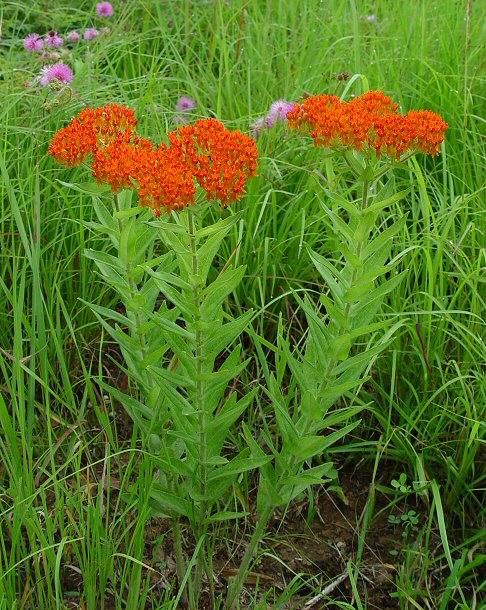Asclepias tuberosa L.
Butterfly Weed

Native
CC = 5
CW = 5
MOC = 82
© DETenaglia
Asclepias tuberosa L.Butterfly Weed | |
 |
Native CC = 5 CW = 5 MOC = 82 |
© DETenaglia |
|
Family - Asclepiadaceae Habit - Perennial forb with deep rhizomes. Stems - Ascending, erect, or arched, to 90 cm, often branched toward the tips, densely hairy, with clear sap, with numerous nodes.
Leaves - Mostly alternate, numerous, simple, sessile or short-petiolate. Petioles to 3 mm long. Blades to 10 cm, linear-oblong to lanceolate, entire, acute, truncate at the base, often with slightly revolute margins, pubescent above, more so below, green above, lighter green below.
Inflorescence - Terminal and axillary umbels, one to several, sessile or short-stalked, with 6-25 flowers. Pedicels subtended by linear bracts to 1 cm long, 1.2 mm broad. Pedicels 2 cm long, with antrorse pubescence, light green.
Flowers - Calyx lobes 5, reflexed, hairy, 2-4 mm long, linear to elliptic- lanceolate. Corolla lobes 5, reflexed, glabrous, bright orangish yellow to reddish orange, 6-10 mm long, lanceolate to elliptic. Gynostegium appearing stalked (the column visible below the bases of the hoods), bright yellowish orange to reddish orange, the corona conspicuously longer than the tip of the anther/stigma head. Corona hoods orange, 4.5-6.5 mm long, ascending, attached near their bases, lanceolate in outline, the tips rounded, the margins with a pair of short, triangular teeth or lobes below the middle, the bases not pouched. Horns orange, to 3 mm, glabrous, attached below the middle of the hoods, extended to about the tips of the hoods and angled or somewhat curved inward over the anther/stigma head, linear, not flattened, tapered to a sharp point at the tip. Column 3 mm long, greenish. Pollinia 2 mm long, translator deep purple. Pistils 2, 2.1 mm long, with a few antrorse hairs at the apex.
Fruits - Follicles 8-15 cm long, erect or ascending from ascending or deflexed stalks, narrowly lanceolate in outline, pubescent. Seeds with the body 5-7 mm long, the margins narrowly winged, the terminal tuft of hairs white.
Flowering - May - September. Habitat - Prairies, glades, open woods, disturbed sites, waste ground, roadsides, railroads. Also cultivated. Origin - Native to U.S. Other info. - This unmistakable plant grows throughout most of Missouri. Its range extends throughout much of the central U.S. and into Canada. It is trivial to recognize, and is the only species of the genus in Missouri to lack the milky white juice so commonly associated with the genus.
The species has been subdivided according to variations in leaf morphology, with Missouri plants belonging to ssp. interior. The flower color in these plants is usually rich orange or red-orange; however yellow-flowered plants are occasionally encountered. Steyermark called these form lutea. This striking form is shown below.
Photographs taken off Hwy 106, Shannon County, MO., 6-6-03 and at Devil's Well, MO., 6-27-03, and off County Road 2010, Lawrence County, MO., 6-16-05 (DETenaglia); also Shaw Nature Reserve, Franklin County, MO, 7-29-2006; Cuivre River State Park, Lincoln County, MO, 6-13-2009; Crowley's Ridge Conservation Area, Stoddard County, MO, 10-5-2011; and Little Lost Creek Conservation Area, Warren County, MO, 6-9-2017 (SRTurner). |